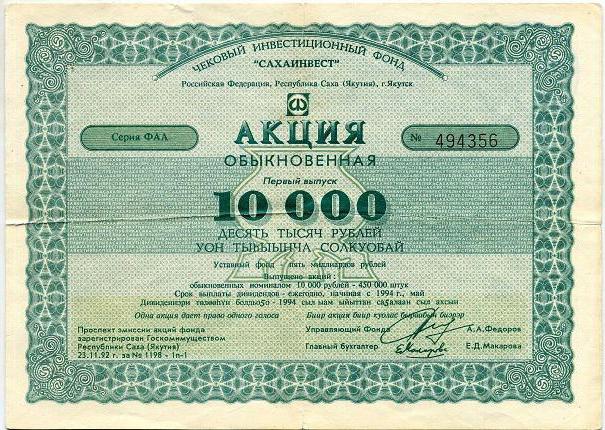Why do we need our own shares? When purchasing such securities, you invest your money, taking into account future income. You will be paid interest on the purchase of the relevant values by the organization that put them up for sale. In turn, organizations can repurchase their securities in order to increase their value.
What are treasury shares
You should first deal with the term. A stock is a document reflecting the share of ownership of a company that secures the rights of its owner to receive joint-stock company income in the form of dividends.

Own shares that are redeemed from shareholders are securities issued by the organization itself and subsequently redeemed by it. Most stock repurchases occur on the stock exchange. It should also be said that shares can be preferred and ordinary.
Types of shares
There are ordinary and preferred shares, documentary and uncertificated, registered and bearer. Ordinary shares to its holder give the right to vote at meetings and income from the results of the organization. Preferred securities do not give their holder the right to vote, but at the same time they guarantee the payment of money, since the settlement of debts begins with preferred shares.
 Documentary shares are shares that are issued on paper, but their popularity is declining nowadays. Now they use mainly a non-documentary form. All registered data of the owner is recorded in registered securities, and he cannot sell such a share without notifying the joint-stock company. In bearer shares, the name of the holder is not indicated, and ownership rights belong to the holder of the certificate.
Documentary shares are shares that are issued on paper, but their popularity is declining nowadays. Now they use mainly a non-documentary form. All registered data of the owner is recorded in registered securities, and he cannot sell such a share without notifying the joint-stock company. In bearer shares, the name of the holder is not indicated, and ownership rights belong to the holder of the certificate.
Features of own shares repurchased from shareholders
Holders of such shares do not have a voting right, dividends are not paid on them, nor are they taken into account at the time of the vote count. The term of use of own shares should be at least one year, otherwise the company will be forced to lower its authorized capital by redeeming its securities.

In almost any country, the repurchase of own shares is a fairly common occurrence. The reasons include the increase in the amount of income, the compulsion to provide better conditions on the exchange for own valuable instruments, etc. We can also determine how many shares an organization can buy back. To do this, multiply the amount of net assets by 10%, divide by 100% and the redemption value of one share.
Federal Law No. 208
Federal Law No. 208 "On Joint-Stock Companies" states that a joint-stock company may buy shares issued by it by purchasing part of such shares in order to reduce their number when such a verdict is passed by the general meeting. But one requirement must be met: the initial price of shares should not be lower than the minimum value of the authorized capital of the organization. Own shares repurchased from shareholders for the purpose of subsequent sale or cancellation are not classified as financial investments.
Own shares in accounting
Own shares repurchased from shareholders are reflected in account 81 “Own shares”. This account is active, and it takes into account information about existing shares repurchased by the organization from shareholders. The debit takes into account the costs of their redemption from shareholders, and the loan reflects their cancellation.The debit balance shows how many shares the company has at the end of the reporting period. If you bought your own shares from shareholders, the transaction will be as follows: debit 81 and credit of the account of monetary values in the amount of actual costs.

If they are canceled, then the transaction is made: debit 80, credit 81. The resulting difference between the cost of purchasing securities and their nominal value is credited to account 91 “Other income and expenses”. The register for the synthetic accounting of personal shares is warrant No. 12. The purchase of such a security takes place at a price determined by the board of directors, but it should not be lower than the market price, which an independent appraiser should determine. The joint-stock company must redeem the security no later than thirty days after the expiration of the term for the requirement to redeem the share.
According to IFRS, own equity instruments are not considered financial assets and should be minus from the capital of the company. According to the application of the chart of accounts instructions, personal shares purchased from participants must be accounted for in the amount of expenses incurred for their acquisition. According to the same instruction, if the sale amount of our shares turned out to be higher than the cost of their acquisition, then this difference is recorded in additional capital as share premium. Own shares are reflected in the balance sheet on line 1320. All profits or losses from operations with our own shares should be reflected in the capital accounts of the enterprise.
Own shares in the balance sheet
As we know, an organization can direct no more than 10% of the value of its net assets to buy out its own shares. Own shares are not assets for a joint-stock company, since there will be no increase in economic benefits from them, but only a decrease in capital.

In the balance sheet own shares repurchased from shareholders are reflected in the third section, which is called "Capital and reserves" on line 1320, but in parentheses, because it leads to a decrease in the capital of the organization. Further, there are two options for the continued existence of assets: either their resale or cancellation. We annul the following transaction: debit 80, credit 81. In case of their sale, we can increase the value of assets and therefore make the following transaction: debit 51, credit 81. A competent specialist should be able to determine the shares owned by the organization and correctly reflect them on the corresponding accounts during operations.
Redemption Methods
The first method is when an organization buys its previously sold shares at open prices at open auctions on the stock exchange until the required quantity is purchased. The downside for the buyer is that the seller can increase the initial price of the stock. The second way is to buy through an option. An option is a contract according to which you can acquire an asset. The issuer sends you an offer to conclude a deal with the indicated price of the asset. You can agree or refuse to conclude such a transaction. An option may also be open.

In this case, the buyer must leave a request for the purchase of such an asset, as it will be freely available on the market. The second method attracts investors more. Participation in the stock exchanges will help you make good money if you understand the economy, keep up to date with the latest and future news about the state of the economy, and spin in the appropriate circles. If an organization intends to re-acquire its own securities, then this indicates its stable financial position or that it believes that its shares have fallen in price too. Through this operation, the organization maintains the price of equity instruments in times of crisis, thereby guaranteeing the security of your investments for the long term.
Price Manipulation
But there is an unfair side to the issue.That is, issuers of their own securities can purposefully manipulate prices. Due to the buyback procedure, specialists will be forced to record an increase in the value of shares and, accordingly, the organization itself. In order not to fall into this trap, it is necessary to study the market environment in which such an operation took place. If you notice that the acquisition occurred at the time of the highest price, which was only in history, then we can talk about price manipulation.